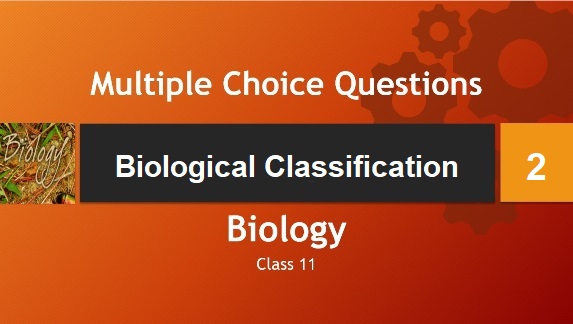CBSE Class 11 Chemistry Chapter 2 Biology Biological Classification Multiple Choice Questions with Answers. MCQ Questions Class 11 Biology Biological Classification with Answers was Prepared Based on Latest Exam Pattern. Students can solve NCERT Class 11 Biology Biological Classification MCQs with Answers to know their preparation level.
Students who are searching for NCERT MCQ Questions for Class 11 Biology Biological Classification with Answers are compiled here to get good practice on all fundamentals. Know your preparation level on MCQ Questions for Class 11 Biology with Answers. You can also verify your answers from our provided MCQ Class 11 Biology Biological Classification with Answers. So, ace up your preparation with MCQ of Chapter 2 Biology Objective Questions.
MCQ Questions Class 11 Biology Biological Classification with Answers - Set - 2
Question 1:
Question. Which of the following is a fungus?
(a) Nostoc
(b) E. coli
(c) Yeast
(d) Chara
Correct Answer – (C)
Question 2 :
Question. Many blue-green algae occur in thermal springs (hot-water springs). The temperature tolerance of these algae have been attributed to their
(a) mitochondrial structure
(b) importance of homopolar bonds in their proteins
(c) cell wall structure
(d) modern cell organization.
Correct Answer – (C)
Question 3 :
Question. Bacteria lack alternation of generation because there is
(a) neither syngamy nor reduction division
(b) distinct chromosomes are absent
(c) no conjugation
(d) no exchange of genetic material.
Correct Answer – (A)
Question 4 :
Question. Which of the following statements is incorrect?
(a) Prions consist of abnormally folded proteins.
(b) Viroids lack a protein coat.
(c) Viruses are obligate parasites.
(d) Infective constituent in viruses is the protein coat.
Correct Answer – (D)
Question 5 :
Question. Which one of the following is wrong for fungi?
(a) They are eukaryotic.
(b) All fungi possess a purely cellulosic cell wall.
(c) They are heterotrophic.
(d) They are both unicellular and multicellular.
Correct Answer – (B)
MCQ Questions Class 11 Biology Biological Classification with Answers
Question 6 :
Question. The main role of bacteria in the carbon cycle involves
(a) chemosynthesis
(b) digestion or breakdown of organic compounds
(c) photosynthesis
(d) assimilation of nitrogenous compounds.
Correct Answer – (B)
Question 7 :
Question. Which of the following shows coiled RNA strand and capsomeres?
(a) Polio virus
(b) Tobacco mosaic virus
(c) Measles virus
(d) Retrovirus
Correct Answer – (B)
Question 8 :
Question. The most abundant prokaryotes helpful to humans in making curd from milk and in production of antibiotics are the ones categorised as
(a) cyanobacteria
(b) archaebacteria
(c) chemosynthetic autotrophs
(d) heterotrophic bacteria.
Correct Answer – (D)
Question 9 :
Question. Puccinia forms uredia and
(a) telia on wheat leaves
(b) aecia on barberry leaves
(c) pycnia on barberry leaves
(d) aecia on wheat leaves.
Correct Answer – (A)
Question 10 :
Question. Difference in Gram positive and Gram negative bacteria is due to
(a) cell wall
(b) cell membrane
(c) ribosome
(d) cytoplasm.
Correct Answer – (A)
- NCERT Solutions Class 11 Chemistry Chapter 1 : Some Basic Concepts of Chemistry
- NCERT Solutions Class 11 Chemistry Chapter 2 : Structure Of The Atom
- NCERT Solutions Class 11 Chemistry Chapter 3 : Classification of Elements and Periodicity in Properties
- NCERT Solutions Class 11 Chemistry Chapter 4 : Chemical Bonding and Molecular Structure
- NCERT Solutions Class 11 Chemistry Chapter 5 : States of Matter
- NCERT Solutions Class 11 Chemistry Chapter 6 : Thermodynamics
- NCERT Solutions Class 11 Chemistry Chapter 7 : Equilibrium
- NCERT Solutions Class 11 Chemistry Chapter 8 : Redox Reactions
- NCERT Solutions Class 11 Chemistry Chapter 9 : Hydrogen
- NCERT Solutions Class 11 Chemistry Chapter 10 : The s-Block Elements
- NCERT Solutions Class 11 Chemistry Chapter 11 : The p-Block Elements
- NCERT Solutions Class 11 Chemistry Chapter 12 : Organic Chemistry: Some Basic Principles and Techniques
- NCERT Solutions Class 11 Chemistry Chapter 13 : Hydrocarbons
- NCERT Solutions Class 11 Chemistry Chapter 14 : Environmental Chemistry




